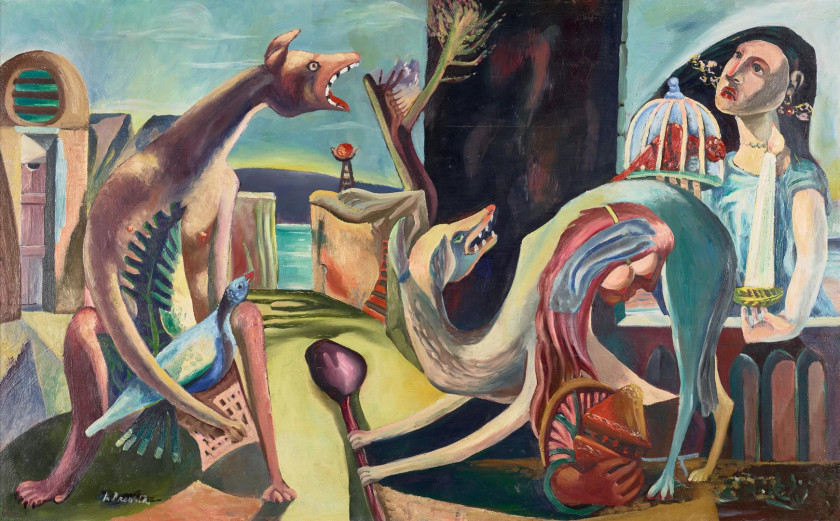Diálogo [Dialogue]
painting


1939
Oil on plywood
61 x 99 cm
Born in Santa Luzia, Azores, in the same tragic year as the outbreak of the First World War, António Dacosta's destiny would be haunted by catastrophes that marked the century. At the age of 21, he went to Lisbon to study Fine Arts and quickly found acceptance among the artistic and bohemian milieu circulating in the capital. There, in the flower of his youth, he published critical texts of exceptional quality in the Diário Popular and produced drawings, illustrations and paintings. He shared a studio with António Pedro, already a respected figure in avant-garde circles scattered around the cafés of downtown, then still surrounded by rural centres, and an obligatory figure at A Brasileira café in Chiado.
It was during these years between 1939 and 1943 that he produced the bulk of his work in the first phase of Surrealism, making him the most important Portuguese artist of that movement launched by Breton and earning him sufficient recognition to win the Souza Cardoso Prize in 1942. He would again win such recognition during 1980s. With a rare work interrupted for three decades between 1949 and 1975, Dacosta was twice an exceptional case who profoundly influenced the various contemporaries he met.
Diálogo (1939) is all the more remarkable because it is perhaps the first full-length work of this Surrealist imaginary invented in Portuguese art. The suffocating atmosphere that the characters inhabit anticipates that of Episódio com um cão, from 1941.
It is always on an island that these theatres of Chirican memory take place, and the hybrid figures of a man and a dog in dialogue with a woman may be figurations of those beings without a destination created by Salazarism, from which the artist would definitively distance himself when he left for Paris in 1947. There, faced with the ruins of the war, he decided to abandon painting and embarked on a wandering phase, in which he dispersed himself between writing magnificent chronicles on art, published in Brazil (O Estado de São Paulo, for which he was a correspondent) and occasional work. This exile was interrupted in 1977 when he returned to painting, which he exhibited at Galeria 111 (1983) and which, shortly afterwards, would be seen on a larger scale in the Gulbenkian Foundation's major retrospective.
Bernardo Pinto de Almeida